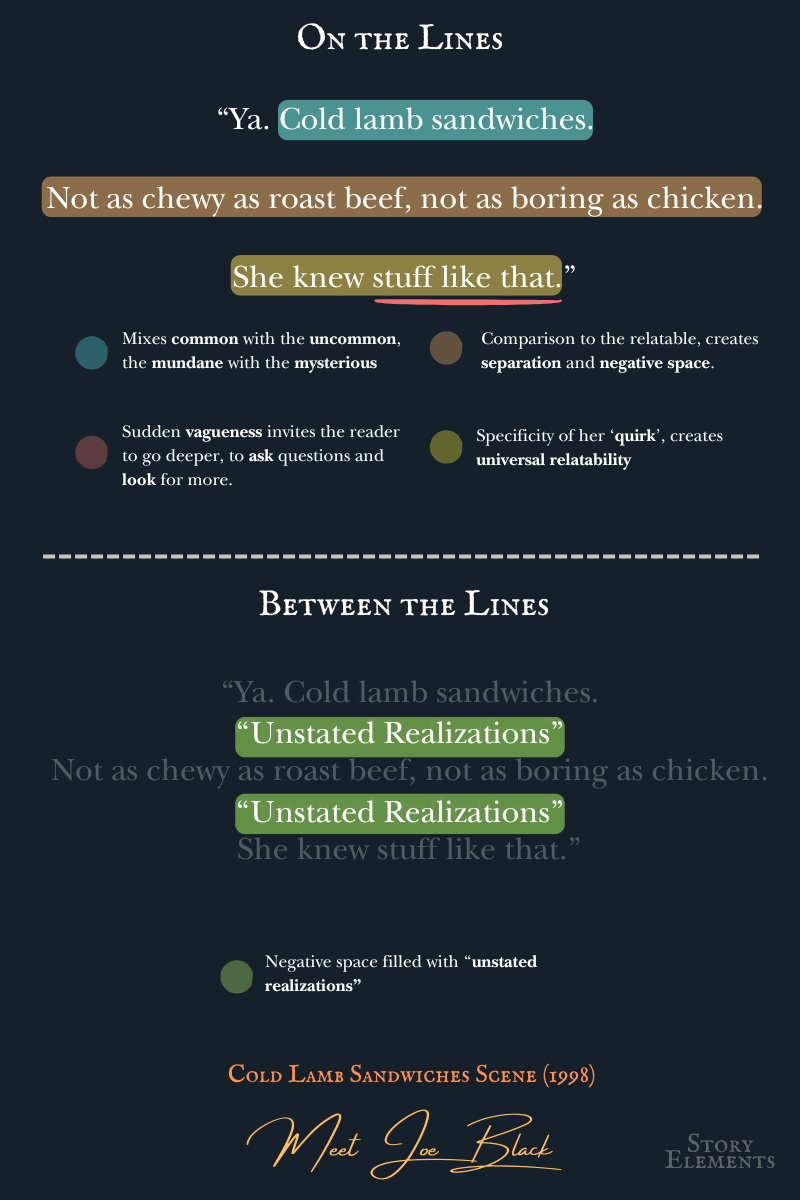- Story Elements
- Posts
- #006: How to Write Between the Lines
#006: How to Write Between the Lines
"Cold Lamb Sandwiches Scene" (1998), Meet Joe Black

It might be silly to point out, but writing between the lines isn’t just about what you leave unwritten, it’s about what you do write. After all, there aren’t any lines to write between until you write on the lines. But there’s more. What’s written between the lines won’t matter if you don’t draw the reader to look for the invisible ink in the first place.
So, how do you create that allure? Two elements: relatability & mystery. And therein lies the beauty of those three magical words:
Cold lamb sandwiches.
This simple line from Meet Joe Black carries more emotional weight than all of Death’s monologues combined. Sandwiches are common and relatable. They’re something we understand and grasp. But cold lamb? It’s uncommon. It’s peculiar. It adds a layer of mystery that punches a hook in our curiosity and tugs at its cheek. It has us asking, “What about cold lamb sandwiches?”
In this scene, these sandwiches are compared to ham and chicken—everyday meats we all recognize. And in doing so, we think we get a better sense of what they are. Tender. Flavorful. But without explicitly stating anything about them, the result is they’re set further apart. They’re isolated in a realm of their own. For all we know they’re also Hannibal Lecter’s favorite sammy or the only item you can order at a bar with a fight club beneath it. And that’s key.
The strategic omission creates negative space, a blank canvas between the lines where readers can paint with their own experiences. All that's left to do is reel them in.
She knew stuff like that.
Here’s why this last line works: it’s vague, yet specific. Unique, yet relatable.
As humans, we want to know what others know. It’s in our DNA. And almost instinctively we ask ourselves, “Like what?” The writers aren’t being vague for the sake of being annoying or because they’re lazy. Their vagueness is an invitation for you to dive deeper and solve their mystery. In fact, great subtext wants you to become a co-creator, to connect the dots, to fill the negative space with what you know, your experiences, and your imagination to the point that you aren’t just seeing the invisible ink, you’re contributing to it. Sometimes in a way that only you can imagine.
Here's what I mean.
What "she knew" about "cold lamb sandwiches" isn't just trivia—it's an intimate detail that belongs uniquely to her character. More importantly, it's a detail he treasures and remembers about her. That's not just character development, Kemosabe. That's love revealed through subtext.
And when you think about it, everyone has a phrase, a smell, a habit that brings someone they love to mind. See what the writers did there? In other words, this scene isn’t just about cold lamb sandwiches.
It’s about our cold lamb sandwiches.
Her perfume. His lame jokes. Your dog’s favorite toy. They’re all cold lamb sandwiches. It’s this relatability that makes the scene bat your heart around inside your chest. And that’s the key to writing between the lines.
Great subtext isn’t about unsaid statements; great subtext is about unstated realizations. As a reader, it’s much more satisfying that way.
So, next time you want your readers to be swept up, when you want them to levitate, when you want them to sing with rapture and dance like a dervish, focus on writing between the lines. Mix the mundane with mystery to catch their interest. Say something without saying anything to create space. Be vague, yet specific. Unique, yet relatable. And most importantly, invite the reader to realize for themselves what you’ve both written between the lines.
Passage to Ponder: How to Cope, Dia Cope

Reply